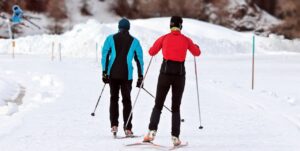Ski pants are so much more than something to protect your legs from the cold. They can be a stylish and functional part of your skiing outfit, but only if you get the right size and fit.
Keep reading to learn how to make sure that your ski pants fit perfectly!
Waist
The waist measurement is the most important number on the pants, since it determines how well they fit.
To get the correct measurement, put the tape measure around your waist where you would normally wear your pants (about one inch above where you’d like them to sit).
The tape measure should be snug but not tight. If you’re between sizes and need help deciding which pant size to choose, go with the smaller option if there’s any doubt at all.
Don’t worry—a little extra room in this area won’t affect how well they function while skiing or snowboarding!
Rise
The rise is the distance from the waistband to the crotch. A high-rise pant will stay out of the way of your bindings and allow you to have full range of motion in your legs.
A low-rise pant will be snug on your waistline—but this can be advantageous if you’re looking for a more form-fitting, flattering fit.
Length
The length of your snow pants should be long enough to cover the tops of your boots. This will help keep snow out and prevent you from tripping on them, which is especially important if you’re on a steep slope.
If you are tall, it may be worth considering a slightly longer pant length (like about 4 inches or 10 centimeters).
If you are short, it may be worth considering getting an extra-short pant whose inseam is about 2 inches or 5 centimeters shorter than usual.
Legs and Bottom
When you’re looking at pant length, the important thing to keep in mind is that they should be long enough to cover your boots.
The bottom of the pant should ideally be wide enough so that it can comfortably cover your boot and provide full protection from the elements.
Another important factor to consider when determining how long ski pants should be is whether or not they have an adjustable waistband.
If your pants are too short, you may find yourself having to roll up the leg every time you bend down or sit down—a major inconvenience that could potentially cause discomfort as well as rips in your clothing if done repeatedly over time.
Set Up and Fit
When you are trying on pants, make sure they fit. You can do this by standing in the store and moving around. Make sure that the pants don’t feel too tight or too loose.
The crotch should be comfortable and not stretch too much over your boots when you walk. If the pants are too big, they will be heavy and fall down at the waist when you move around.
Pants should fit comfortably over your ski boots without being too tight or too loose around your waist, hips, thighs and knees.
Make sure your ski pants are fitted properly
For an optimal fit, look for ski pants with a waist that is snug but not too tight.
The elastic band should be comfortable, but not so loose that it slips or slides around on you.
Ski pants should also have enough length to allow for plenty of movement in the legs without pushing up against your boots or creating any other uncomfortable restrictions.
It’s also important to make sure that the rise of your ski pants is high enough so snow doesn’t creep in through the bottom of them when you’re moving around on skis or hiking up slopes.
Are ski pants meant to be tight
They should be neither too tight or too loose: a happy medium is always best, although for snowboarders, veering towards a looser fit is recommended due to the extra breadth of movements involved in the sport.
Conclusion
As you can see, there are many things to consider when buying ski pants. Don’t just go off price or brand recognition—take your time and get the best fit for you!
